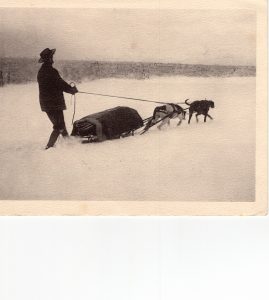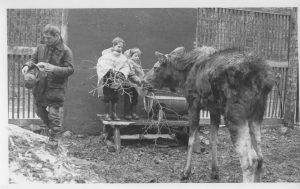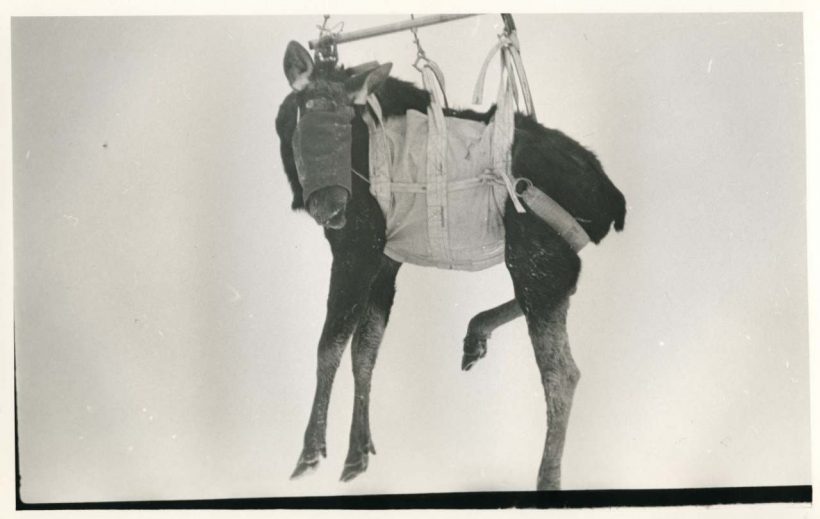PARK PRANKS by Barney Moorhouse
To the trapper who entered Algonquin Park on stilts or the one who strapped his snowshoes on backwards, intent on fooling the game warden, it was no prank. Nor was it to the individual who exchanged his old worn out boots for those of the sleeping park ranger. These guys were attempting to make a living, trying to survive. The lighter side of park life was, and still is, usually associated with camp life as anyone who has attended camp in their youth could confirm.
The Bishop of Birmingham
In 1930 the Bishop of Birmingham was taking time from his busy schedule (sschedule Canadian; skedule American) touring Canada to visit Camp Ahmek, a boys’ camp. He wanted a glimpse of Canadian boys and girls experiencing camp life. The campers were most excited and no effort was spared preparing for such an important visitor. What letters they would write home! A large man, the Bishop struck an imposing figure wearing the traditional hat and “dog collar.”
The ceremonies began at the train station with much pomp, circumstance and speeches. As the day wore on the boys became very suspicious where the Bishop was concerned. They were sure that he was an imposter. The next morning as the official party paddled across the lake to visit Camp Wapomeo – a girls’ camp – the boys sought their revenge and pushed the imposter overboard thus baptizing the Bishop in Canoe Lake.
By coincidence, in 1931, the Governor-General, Lord Willingdon, paid Camp Ahmek a similar visit except this time the campers were skeptical. Again they heard how the Governor-General wanted to see Canada’s youth at play in the Algonquin forests.
Before the Governor-General arrived plans were afoot to deal with the imposter. The campers wouldn’t be fooled twice. They would be very polite and, at the appropriate moment, they would likewise baptize the Governor-General.
Taylor Statten, “Chief” of the camp, got wind of the plot and tried to impress the campers to do nothing foolish. Realizing that the campers were unimpressed Statten appointed a special body guard of trusted senior campers to watch over the guest.
Through his actions Lord Willingdon must have earned some credibility for the campers began to wonder. Was he a phoney or really legit? By the visit’s end there had been no baptism. Which was just as well for Lord Willingdon really was Canada’s Governor-General.
Whiskey Rapids
It was late in the springtime and the log drive through the south-west corner of Algonquin Park was almost over. The men were camped for a weekend rest on the Oxtongue River below Tea Lake (Waskigomog Lake). It had been a long arduous season and all that remained was the trip downstream to the Muskoka Lakes mills. Surely this called for a celebration? The men chipped in financially and arranged with some railway men for a keg of whiskey to be dropped off. The 3 gallons cost $3.85.
Two of the men volunteered to paddle up river from their campsite near the Three Sisters Islands. They portaged a series of rapids and proceeded up Tea and Canoe Lakes to the train rendezvous. On the return trip the men took a vote and decided it was only right that they should savor the first sips from the keg. After all hadn’t they gone to the trouble of fetching the whiskey?

Darkness set in by the time they reached the river and our paddlers began to feel apprehensive for the camp celebration couldn’t start before their arrival. The river was high due to the spring thaw and the current rapidly carried the messengers towards their destination. Suddenly, in the darkness, the bowman realized that they were approaching some rapids.
“Rapids!” he yelled.
“Oh lets shoot them,” came the reply.
The white water carried them quickly onwards and because of the darkness, not to mention some side effects from their ‘sips’, the canoeists failed to navigate the correct channel. By the time they rescued themselves the keg was long gone vanishing into the darkness. Hours of searching failed to turn up their lost nectar. Their return to camp motivated a search party but it too was doomed to failure. Such a memory is kept alive to this day for that stretch of fast water on the Oxtongue River is still known as “Whiskey Rapids”.

On another occasion Superintendent Bartlett was informed of an incoming shipment of illegal booze that was being smuggled into the park by train. Bartlett and park Ranger Robinson investigated. While Bartlett distracted the railway men Robinson quietly discovered that the illicit liquid was hidden in an oil can. Secretly he drained the can and re-filled it with water. No formal complaints were ever registered but at the ‘celebration’ there must have been a lot of raised eyebrows.
Grey Owl
Little Archie Belaney fantasized about being an Indian. When he emigrated to Canada Belaney totally fooled everyone when he assumed the guise of Grey Owl. His most notable achievement was saving the beaver from extinction. Less notable was his bet that he could snowshoe across Algonquin Park without being caught. The park Rangers got wind of this boast and prepared for the challenge. One account claims that Ranger Bud Callahan predicted Grey Owl would follow the old Gilmour Road from Dorset and strike north through the Crown Lake District. Callahan proved right. He soon struck Grey Owl’s trail and discovered the braggart’s camp. Not about to lose a wager so easily, Grey Owl slipped away under cover of darkness while the Ranger slept, leaving his pack behind. The weather turned colder and, travelling in new territory, Grey Owl broke through the ice of a beaver pond. His extra clothing and matches were in the abandoned pack. When Callahan caught up to Grey Owl the fugitive’s feet were frozen. Callahan took Grey Owl to Superintendent Robinson where he was nursed for three weeks in an attempt to save the feet. Once healed Robinson lent Grey Owl the money for train fare home to Timagami. They never crossed paths again. (Note: Robinson’s daughter “Otty” Addison knew and wrote about Tom Thomson. Her son Dr. Ed. Addison was an MNR Research Scientist based in Maple, Ontario and studied moose ticks extensively in Algonquin Park.)

Animal Pranks
Even the animals got into the act. Section hand Charlie Ratan had, according to Superintendent Mark Robinson, “many a quarrel with beaver.” They would build a dam and Ratan would have to tear it down. When Ratan’s pick axe went missing the section hand thought that it was somebody’s idea of a joke but no one would admit to it. When the men next tore the beaver dam apart to avoid flooding the railway tracks, there was Ratan’s pick axe firmly lodged in the bottom of the dam.
Then there were the beaver at Joe Creek that kept damming the railway culvert. The stationmaster would clear it out one day and when he awoke the next morning, the beaver had presented him with a new dam. One night the stationmaster left two lanterns – one at each end of the dam. It worked. The beaver had not returned. And so he placed the lanterns once again the next night and enjoyed an even more peaceful sleep. But when he awoke he was greeted with the sight of an even bigger beaver dam – built by the light of the two lanterns.
To the winter campers at Mew Lake it must have seemed like a prank when moose began flying overhead in the early hours of the morning but after a while they became acclimatized to the action and acted as if this was a normal everyday occurrence.
“Is that another chopper that I hear?” calls a voice from the tent.
“Yes, dear; it’s just another flying moose. Say, what’s for supper?”
And the moose were flying. But not all the way to Michigan’s Upper Peninsula as one news cast reported. The Ministry of Natural Resources was flying the moose to a staging site at Mew Lake. From there they would be trucked to Michigan’s Upper Peninsula as part of a re-introduction program in the 1980s.
Garvie
The final word goes to a park joker – Paddy Garvie. Garvie needed new shingles for his cabin but the McLachlin foreman wouldn’t part with even one. The company needed them. Garvie would have to make his own probably using a draw knife and some chunks of “corky” white pine. Soon after a dam broke flooding the company’s store yards. When Garvie saw the shingles floating by he wasted no time gathering them up to shingle his roof. When the McLachlin foreman arrived looking for lost property he had no way of proving that the shingles belonged to his company.
Garvie ordered an organ for his stopping place at the Depot. Ever the optimist, when he was asked about affording such an expensive item he replied: “All it cost me was a piece of paper.”
This article was penned in 1993.

